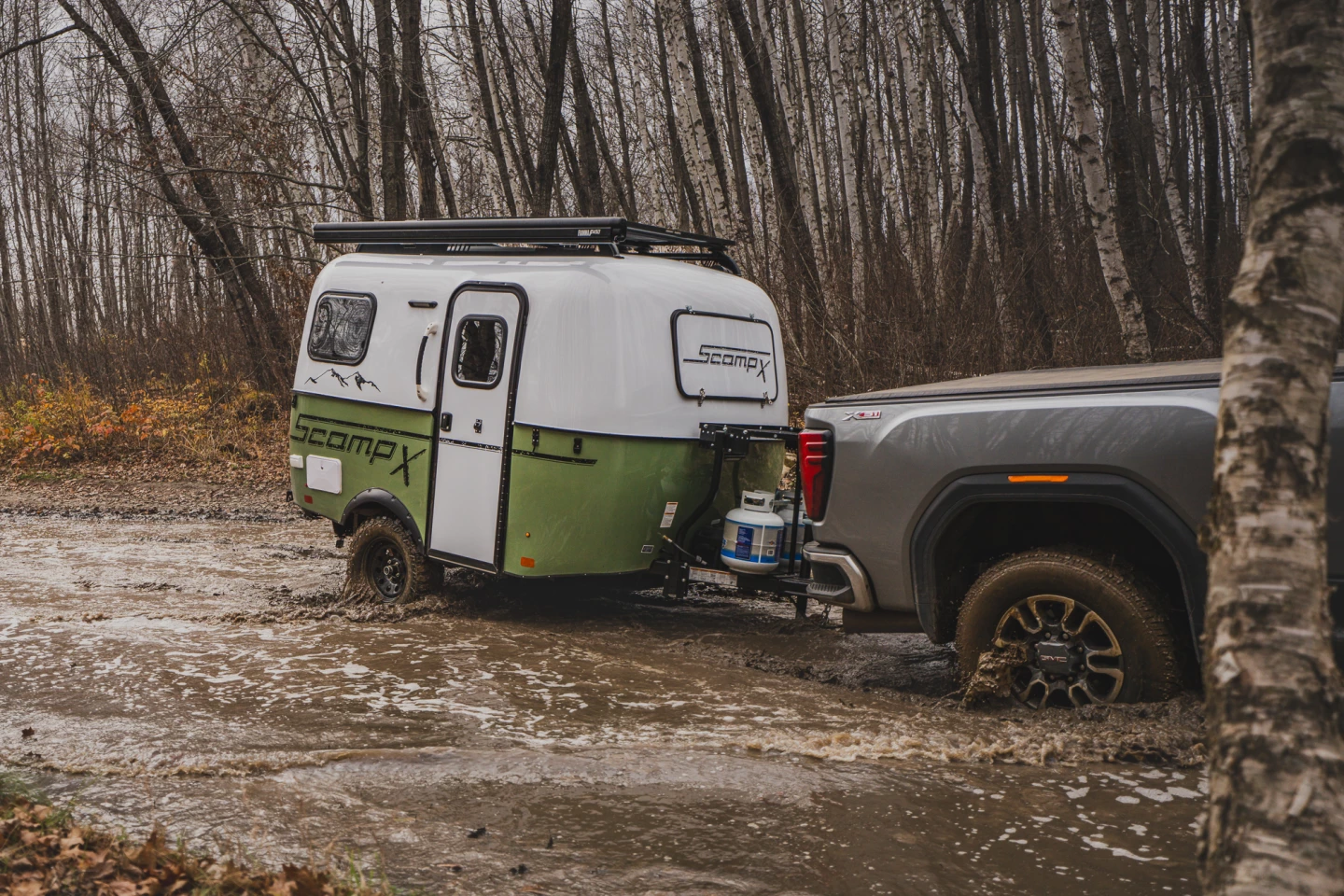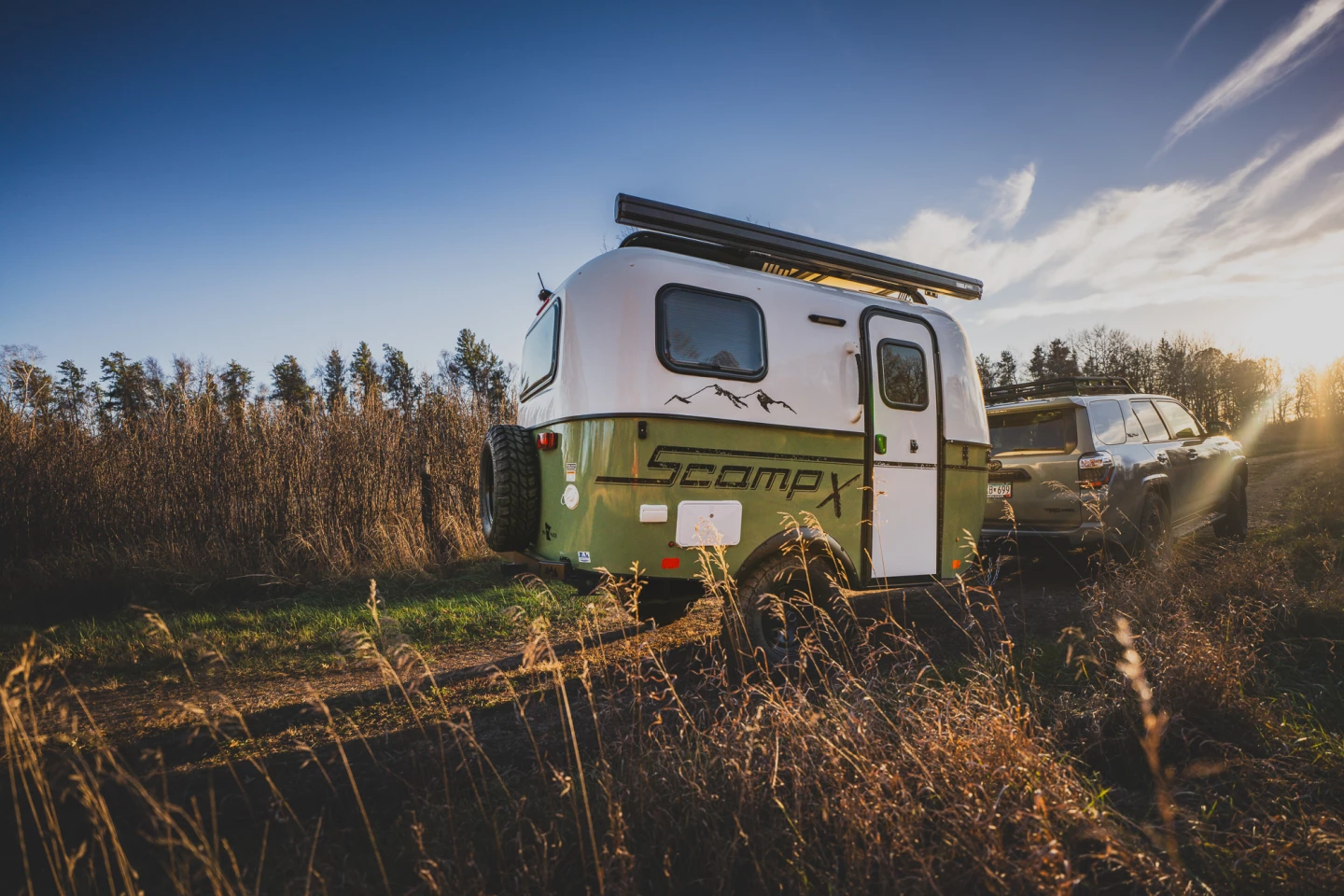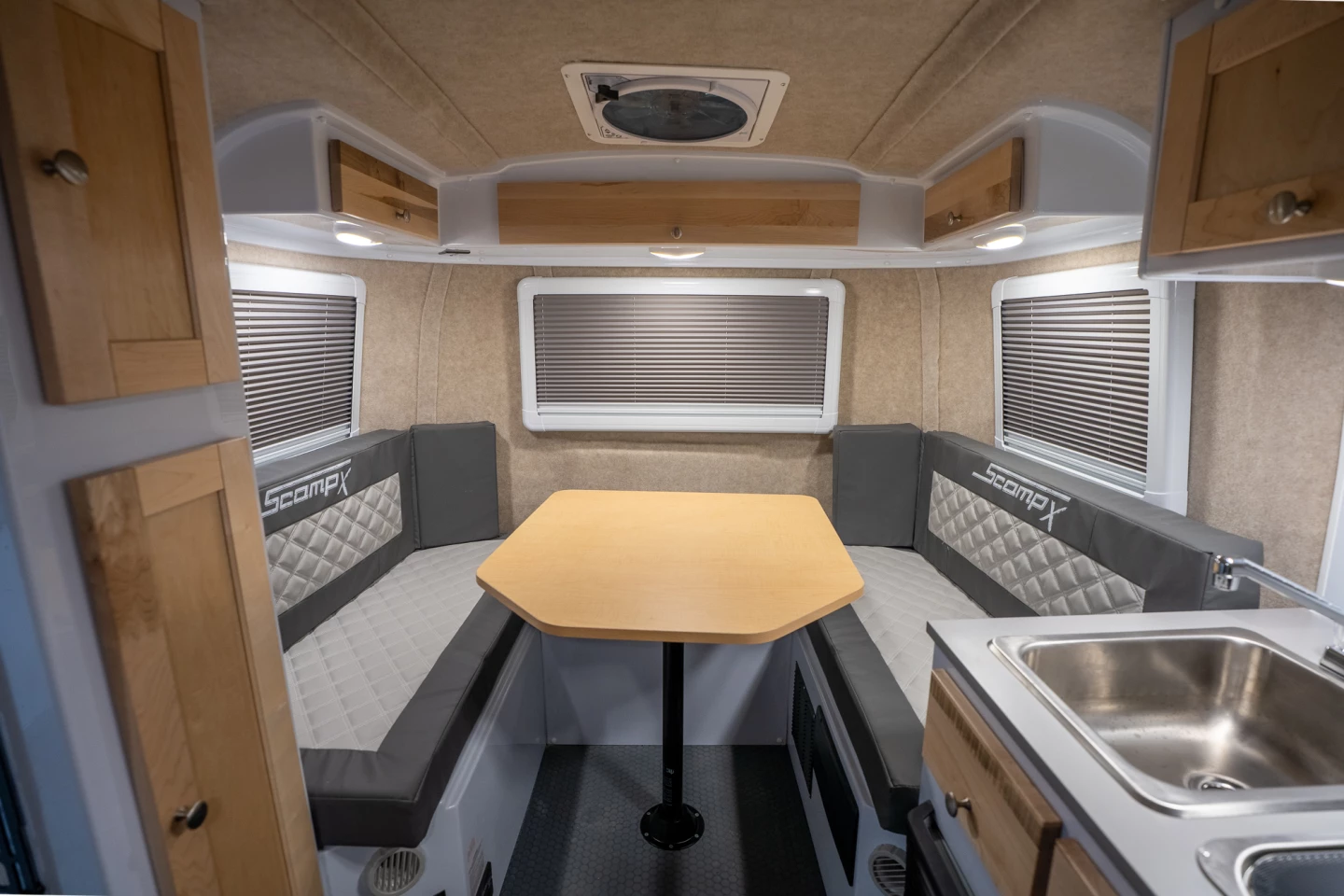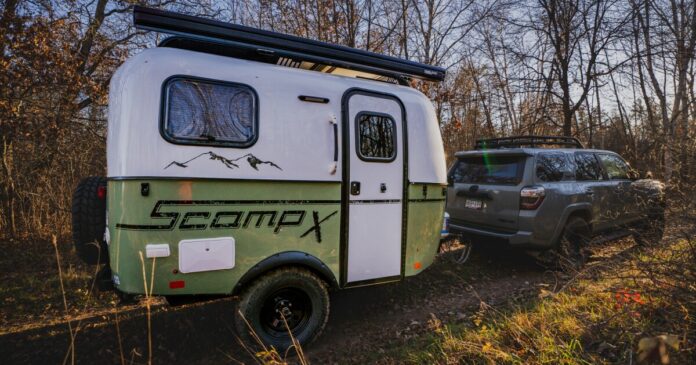Scamp might not be as celebrated in modern circles as Airstream, but it is a similarly iconic camping trailer brand with deep history. Its roots dig all the way back to the market’s original fiberglass camper icon, and much of its modern lineup looks virtually unchanged from those classic fiberglass pods of the 1960s and 70s. This month, though, the Scamp family flashes a new look with the Scamp X, a ruggedized, all-terrain design that updates the iconic egg trailer for modern deep-wilderness adventure. The X is Scamp’s first off-road-specific model in more than 50 years in business.
Before the Scamp, there was the Boler. Built in 1968, the original Boler trailer is popularly credited as being the market’s first successful fiberglass trailer, leveraging fiberglass’ high strength-per-weight and leak-free integrity into a production-bound design. Creators Ray Olecko and Sandor Dusa rolled out the 13-foot (4-m) 800-lb (363-kg) four-sleeper travel trailer that Olecko would use as a personal family camper. The trailer featured upper and lower molded-fiberglass tub shells bonded together to create a curvy RV box that came to be compared to an egg on wheels.
As Boler’s creators worked to grow the trailer from award-winning one-off to marketable product, they looked to expand their footprint and established an American subsidiary in 1971. Boler American was tasked with bringing the advantages of the sleek, new fiberglass 13-footer to the American masses. To do so, it signed up US-based fiberglass shops and tradesmen to serve as manufacturing partners, including a Minnesota mobile home remodeler named Duane Eveland.
Boler American proved quite short-lived and filed for bankruptcy just a year later in 1972. Eveland’s Inc., founded by Duane Eveland and his siblings Gerald and Gladys, was left with the 13-foot Boler molds but none of the business and marketing support Boler American was to provide under the deal. It reorganized and rebranded the trailer as the Scamp, building out its manufacturing footprint in Backus, Minnesota and increasing production of the original trailer each year before adding 16- and 19-foot (4.9- and 5.8-m) models in the late 70s and early 80s.
Scamp long outlasted Boler (Canada) itself, which went out of business in 1988, and became as synonymous as the originator with the style of compact, curvy fiberglass trailer still known fondly as an “egg” trailer. Other brands like Trillium and Casita emerged over the decades with similar designs of their own, and more recently brands like LA-based Happier Camper and British Columbia’s Armadillo Trailers (the latter now defunct) have emerged to help ensure the timeless design isn’t forgotten in the 21st century.
Scamp
Today, Scamp continues to operate from its base in Backus, Minnesota and is still owned and operated by the Eveland family. Current CEO Micah Eveland, grandson of founder Duane, took over in 2020 after his father Kent’s retirement and seems keen on adding some modern upgrades to the Scamp family without disrupting the vintage fiberglass egg aesthetic that’s made the brand an icon.
Like other fiberglass trailers of the same style, Scamp trailers have long been renowned for their easy-towing, lightweight construction, value-forward pricing, hard-sided leakproof design, and long-lasting durability. It’s not uncommon to see Scamp trailers from decades ago still roaming highways and thriving at campgrounds today.
All those attributes make the Scamp a natural platform for a hard-walled off-road adventure camper. It occupies an intriguing middle ground between off-road teardrops and large, heavy travel trailers and is as timelessly whimsical as a teardrop but with space for a proper floor plan accommodating a family of four.
Given how long Scamp has been operating, we thought maybe we had just missed its past off-road trailer efforts, but the company confirms that this is actually its first off-road-specific model in its 54-year history. That’s as exciting as it is surprising since adventurers looking for a more rugged, off-the-beaten-path Scamp were previously left to convert used Scamps on their own. Now there’s an option available as new straight from the factory … and it’s an eye catcher.

Scamp
The all-new Scamp X features the tried-and-true dual-tub bonded fiberglass construction and style of a classic 13-foot Scamp but adds in some beefed-up running gear to better negotiate rough, shifting terrain. That package places a Timbren heavy-duty suspension inward of ST235/75R15 off-road tires, pushing ground clearance up to 18 inches (46 cm), 6 inches (15 cm) more than the standard Scamp 13.
In addition to the knobby off-road tires, the increased ground clearance is one of the first things you notice about the Scamp X. The original Scamp’s wheel arches sink down over the tires, while the X’s are completely above. Scamp further accentuates this difference with the type of contrast flares automakers often use for 4WD/AWD models. It also adds an “X” graphics package atop an olive green/white paint split to further distinguish the new trailer.

Scamp
The Scamp X floor plans carry over from the Scamp 13, though they’ve been rebranded into the more outdoorsy “TRK” and “ALT” packages. The two packages give buyers the option of a wet bathroom (ALT) or bunk beds at the front of the interior, the latter fulfilling four-person sleeping capabilities with its combination of two 76 x 30-in (193 x 76-cm) front bunk beds and a rear 76 x 54-in (193 x 137-cm) double bed converted over from the U-bench dinette. The bunks transform into an extra sofa during the day.

Scamp
Both floor plans include a central galley block with dual-burner gas stove, sink and under-counter fridge. The Scamp X isn’t necessarily fully optimized for off-grid boondocking, but it does include double the propane capacity of standard 13-foot Scamps, packing in two 20-lb tanks. A 400-W solar panel system is available optionally for charging the onboard 27 Series leisure battery.
The Scamp’s composite floor is secured to the steel chassis below and topped inside with a tractive rubber coin surface. Other standard features include a water heater, 45-L fresh water tank, 45-A power converter, and 30-A shore power hookup with cable. An articulating hitch provides a better range of motion for uneven terrain, while electric brakes help pull it to stop. The 2-in hitch receiver in back lets owners attach bicycle racks and other carry systems.

Scamp
The Scamp X has a base weight of 1,986 lb (900 kg) and a 3,500-lb (1,588-kg) gross vehicle weight rating thanks to the upgraded Timbren HD 3500 suspension setup. It’s available to order now for a starting price of US$28,495. Additional options on offer include a furnace, air conditioner, lithium battery package, roof rack package, awning, TV/Starlink satellite internet package, portable toilet and outdoor shower.
In addition to its Backus, Minnesota HQ, Scamp opened an all-new Phoenix facility in 2024 that serves as a sales showroom and parts and service center.
Source: Scamp


